We first heard about Whisper from our friend and former adopter Laura Clarke, who is also a police officer with the City of Snohomish. She called to ask for our help in caring for three horses that had been seized from a 27-year old woman who lived within city limits — one horse was already found dead on the property and another, a 2 year old grulla pinto filly Laura had named “Whisper”, was in dangerously poor condition. It was December 7th, 2008.
The story we received is that Whisper went down and couldn’t get up, and the owner called a vet from Pilchuck Animal Hospital out. They found Whisper on her back in a trough she had dug for herself, feet in the air. She was severely emaciated and dehydrated and the vet administered an IV and told her to blanket the filly. The owner contrived a blanket out of a sleeping bag and a shower curtain, tied on with baling twine. The owner had put the other three horses in an neighboring pasture and told the vet they were not hers when asked. The next day, a neighbor saw that one of the other horses (a half sister to Whisper) was dead and contacted Animal Control and the police, and when they arrived on the scene, Whisper was nearly dead.
The city Animal Control, since they had no place to put a horse, contacted Laura knowing she had horses and has worked with horse rescues, and asked her to take the horses, and Laura obliged. A vet was called for the filly and the city, worried about the expenses of caring for these horses with no budget to do so, reached out to the media for help. But what these horses really needed, were a place to go, a rescue group. And Laura called the rescue groups, and the response she got was the same — all full. That was true even for SAFE, still at max capacity from taking the 16 horses from the Jean Elledge seizure earlier in the year, we simply did not have room for the horses, not even Whisper. Laura, being a horse lover, rescuer, and also an officer involved in the case, took the horses in herself. As Whisper was near death at the time of her rescue, and had to be lifted into the trailer, she continued to struggle after her rescue. She was having trouble maintaining her body temperature, and having trouble getting to her feet after lying down. She had several large pressure sores on her body from being down and struggling, including one on her left stifle that was very large and swollen. She had very bad mud fever and her legs were very swollen. She had several areas where her skin had been rubbed raw — including on her face from what must have been a halter. She was supposedly around 2 years old, but only about the size of a yearling. Her body condition score was a 1.5, so she was heartbreakingly thin.
A week later, the filly was still alive but was still hovering near death and Laura was at her limit trying to care for the emaciated filly and do her job and manage her own farm and small boarding facility. When Whisper would lie down, she would be unable to rise and required as many as 7 people to help lift her to her feet again. She called us again, begging for SAFE to help, and offered to take one of our healthy horses as a temporary foster so that we could make room for Whisper. She had found foster homes for the other two horses, but Whisper needed intensive care, beyond what she could provide for her. And so it was arranged that Summer went to Laura’s, and Whisper arrived at SAFE, just as we were about to have one of the biggest snow events and deepest freezes Western Washington had ever seen.
When we first laid eyes on Whisper, we were amazed she was still alive. There was nothing left to her but skin and bones, her thick winter coat was matted, filthy, and full of fungus, with huge raw patches on her thigh and shoulder from lying down for long periods of time being unable to rise. Her head seemed gigantically out of proportion to her neck and body. She was young, you could tell from the fact that her body was suspended in mid-growth phase, her rump nearly three inches taller than her wither, but her head looked more like that of a geriatric donkey than belonging to a horse. The only thing that gave us any hope when we looked at Whisper was her eye, which was bright and still interested in her surroundings, and told us that she was still very much interested in being alive. She whinnied as the trailer door opened and carefully but with a surprising amount of spunk jumped out of the trailer onto the freshly fallen snow. She was even a little pushy and rude when led to her stall, reminding us that she was still a baby and probably not one with much handling. But she was also sweet, and curious and interested in anyone who came into her stall.
That first day, Dr. Hannah came out and tended Whisper. Her temperature was 98 degrees, quite low and the temperature outside was in the teens, down to single digits at night. We wrapped her up in three blankets and added heat lamps. We put standing bandages on her legs to help with the swelling and applied Nolvasan to her wounds. She had chunks of mud that was frozen and stuck her to body, and attempts to remove them would result in the hair falling off leaving raw skin below, so we were forced to leave them. We began feeding her the refeeding diet of small amounts of hay every few hours. The first few days, Whisper remained standing and we were hopeful that she was getting herself down and up in the night.
After 5 days at SAFE, the weather worsened and the wind kicked up in addition to the frigid temperatures. We nailed boards in front of the stall to try and block the wind. That morning she was found down in her stall, and she appeared to have been down for a while. Her temperature was a dangerous 97 degrees, her gums were pale, and her eyes were flickering in a way that we later learned was an indicator of late-stage hypothermia, just before death. Any attempts to get her to rise were futile, she seemed not to even notice anyone around her. A reporter from the Everett Herald was at SAFE, hoping to do a story about Whisper’s recovery, and instead was enlisted along with the help of as many volunteers and friends that we could rustle up to lift Whisper to her feet (read the story here). Dr. Hannah was out on a call and unable to get there in time so Dr. Miller from Pilchuck arrived just as we got her to her feet. Once she was up however, Whisper once again perked up, and hungrily dived into the steaming beet pulp mash we had waiting for her. Dr. Miller’s prognosis was guarded, but the filly was stable.
When the news story hit, we put out a call for a heated barn for Whisper to go to, as it was so terribly, horribly cold. We also put out the word that we were in need of a sling to help hoist her to her feet. A few offers came in, but none close and we were worried about driving and the icy conditions. We decided the best thing would be to take her to Pilchuck, which had a heated barn, and we were ready to do this when we found out that their heaters were broken. We ended up deciding to use a friend’s barn a few miles down the street, which could be enclosed and heated and at least get her out of the wind. After another night of frigid temperatures and again calling in volunteers to help lift her to her feet at 11pm at night (it took 8 people to do this), we managed to get Whisper to Lisa’s house and safely in her enclosed, deeply bedded stall, before another blast of winter snow and wind arrived. It was December 20th, five days before Christmas.
And so began a heroic effort on the part of so many people to save this filly. The weather continued to work against us and Whisper continued to lie down after she could no longer stay standing any longer, and then be unable to rise again and have to be lifted to her feet. She was now running a temperature, and antibiotics were started, but when she went down her temperature would once again plummet and hypothermia was the biggest danger. We brought her hot mashes, and heated water to drink. We started her on Ranitidine for ulcers. We managed to get the temperature in the barn up to about 40 degrees, despite below-zero temperatures and strong winds outside. When she was down, she was listless, exhausted, her heart rate elevated from the stress of trying to rise. But when she was up, she was charming, so sweet, so curious and friendly and full of life that we all just couldn’t help but keep fighting for her. And so a large crew of us began taking shifts, checking on Whisper every two hours overnight, ready to call in the troops of volunteers when needed to lift her.
By December 22nd, we were all exhausted from heaving Whisper to her feet several times a day and throughout the night. We decided to rent a sling from Mount Vernon Animal Hospital. An electric hoist, after trying in vain to find one to rent, was purchased by a friend of Geri Vincent’s of Equine Aid and loaned to us to use, which was incredibly generous of him. Geri’s husband and the friend who purchased the hoist worked for hours figuring out a way to install it overhead. The Everett Herald came out and did a follow-up story on Whisper.
On December 24th at 2:00am, we found Whisper down and had the first opportunity to utilize the sling. Whisper was not bothered at all by the commotion of getting the sling under her body, the noise of the electric hoist and even seemed fairly calm as she was being lifted. Once she was to her feet she immediately began eating again. It still took 2–3 people to help position the sling and Whisper and help get her feet underneath her, but it was a significant improvement. After the next few lifts we figured out ways to make it work a bit better, but Whisper would hang in the sling and refuse to help us out at all, and we would still end up having to lift her the last few inches, position her feet underneath her, and hold her until she would bear her own weight.
Christmas was a rough day for little Whisper. She went down around 3:30 in the afternoon, then again about 1:15am. The sling was incredibly helpful but did have its drawbacks. For one, it could not be left on her, so it had to be positioned underneath her first which was no small effort to get it out of the way of her front legs and not rubbing anywhere. Second, it had no hind end support so much of that had to be done by people. Third, because she was lying flat when she was lifted, she ended up being sideways and you had to physically try to position her vertical to get her feet under her, and she would not help you at all. Lastly, it was not mounted high enough so even all the way up, she was only about 3 feet off the ground so while we could get her feet positioned underneath her, she had to not only bear weight but do a bit of lifting her own body weight that last little bit to get herself standing.
By December 30th, we were all exhausted. By this point we had tried several modifications to the sling system, but it still was a struggle to get her to her feet, and she was going down more frequently — as often as 5–6 times in a 24 hour period. Whisper’s heart rate was elevated ‑up to 72 bpm, and she suffered a gas colic that gave us all a scare. We decided she needed to go to Pilchuck, where they could have a professional sling system available for her, a heated barn, and 24-hour care.
Soon after arriving at Pilchuck, Whisper began to rally, and we finally saw signs that she was going to make it after all. Her temperature stabilized in the heated 60-degree barn, and she didn’t even have to wear a blanket. She wore a harness with a head bumper and was attached to the sling during the day, and they let her lie down at night. On January 2nd, Whisper managed to get herself to her feet mostly by herself with only a small amount of assistance. By January 4th, she had gotten herself up on her own three times in a 24 hour period. At this point we began to have hope that she was indeed going to make it.
On January 5th, Whisper left Pilchuck and went to a foster home in Sultan. She had crested the mountain that was her recovery and it was smooth sailing from that point forward. On January 9th, she was beginning to buck and play in her turnout paddock. She was wormed, and dumped loads of parasites. She got her first bath, and we were able to remove the caked mud, feces, and stink off of her and her wounds began to heal and new hair started to grow over her bald patches.
By February, two months after she was rescued and one month after she left the hospital, despite all the odds against her, Whisper had survived. She was truly a miracle.
Whisper was adopted to her forever home in June of 2009. She continues to do well and loves to run in her 10-acre field for the pure joy of running.
Charges were filed in Whisper’s case, and the owner was found guilty of 1 count of Cruelty to Animals in the First Degree. She was sentenced to 12 months community supervision, 90 days electronic home monitoring, and could not possess, own or board any domestic or exotic animal. She was fined $600 in Court fees, plus SAFE and the city of Snohomish were awarded restitution for the cost of the surviving horses’ rehabilitation.

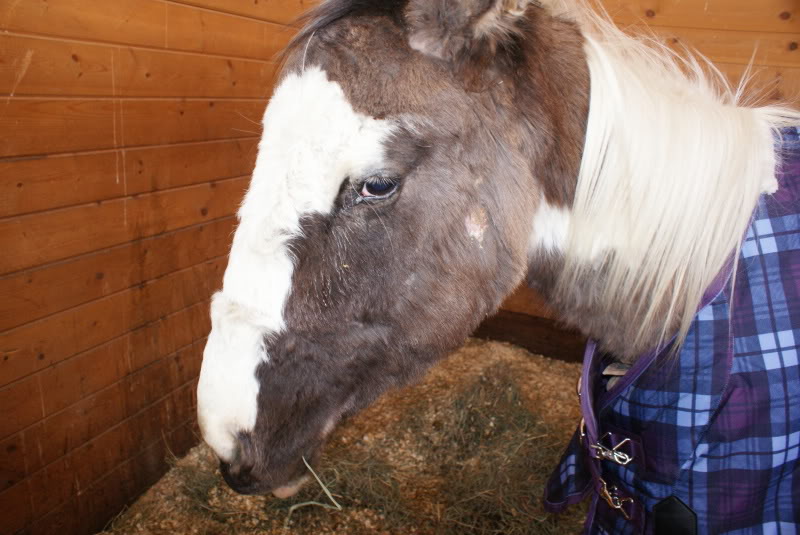
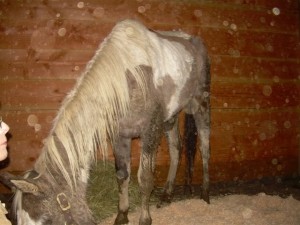
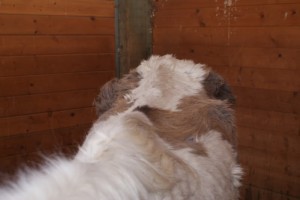
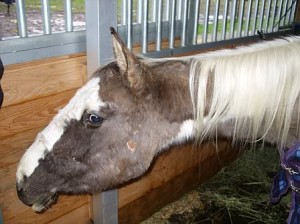
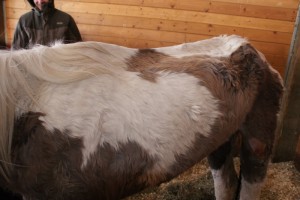
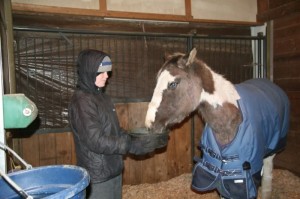
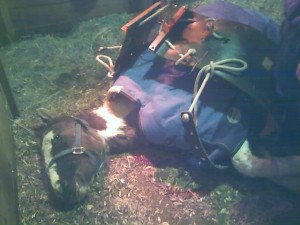
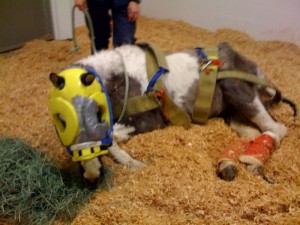
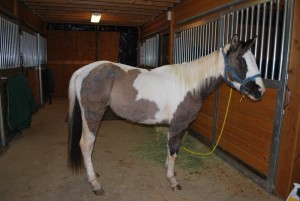
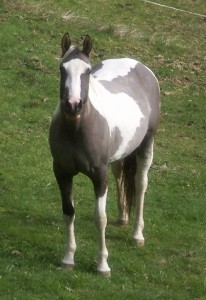

What a heartbreaking and wonderful story in one. So horribly sad that anyone could allow an animal to become so ill, so thin and so unloved. But it is so wonderful to know that many people will move heaven and earth to help an animal. And in all of that it is not only thought-provoking, but motivating to see an animal come from the depths of hell to finally run in wonderful, green pastures.…it took courage, strength and desire and Whisper had all those things and more. Bravo Whisper…may you live a very long and very good life. You deserve it!
I follow the fugly blog; that, coupled with amazing stories like this has convinced me, when its time to add a horsey family member, a rescue is the way to go. Kudos to SAFE and the amazingly dedicated volunteers!!
wow what a wonderful story, doesnt she look amazing now!!! well done to all involved!
Amazing, thank you for sharing this and doing what you do!!
*Gasp* I am simply speechless. Once again I am amazed by what you guys at SAFE do!
Thank you SAFE for saving this gorgeous girl. I remember her being saved on my birthday and knew I had to help support. I recall her fight to live. She looks great and is blessed to have found a wonderful home. Cheers to you and Whisper’s family!
Thank you, Djer! I do remember your generous donation to help Whisper, and now you’ve been equally generous in helping Strider. Thank you so much for caring so much about horses!!